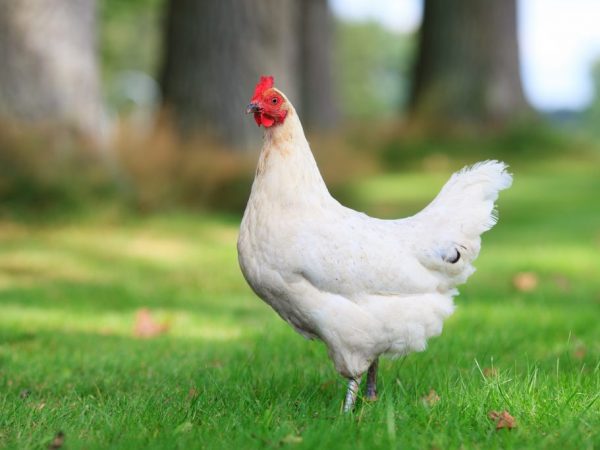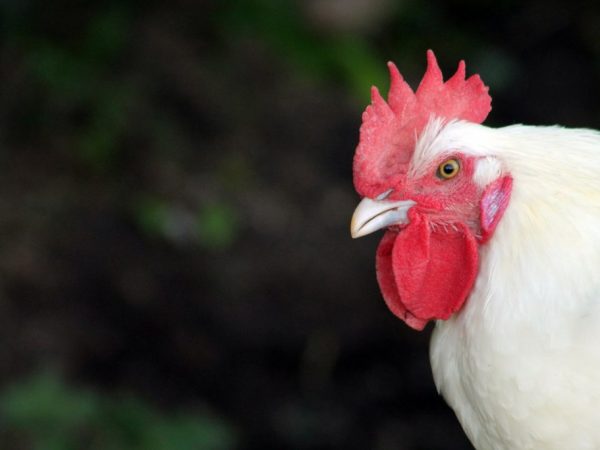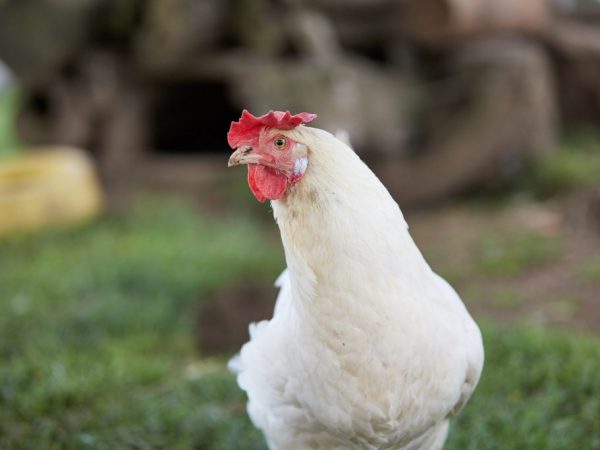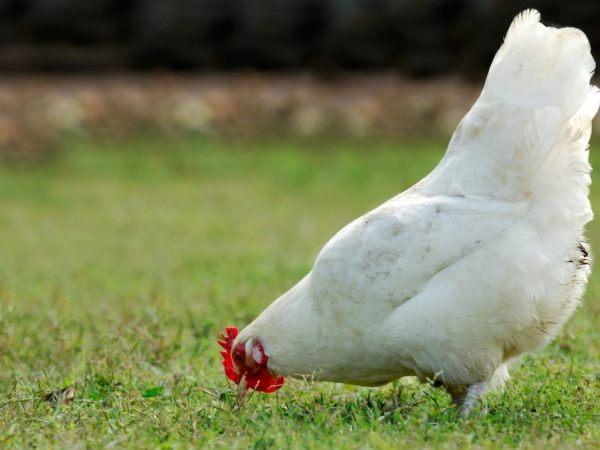Bress Gallic chickens
The Bress Gallic chicken breed developed by French breeders has all the necessary qualities - fast growth, good egg production, tender and tasty meat. In Russia, French crosses of meat and egg direction began to be bred quite recently - 5-7 years ago.

Bress Gallic chickens
Brief information about the breed
- Productivity type: meat and egg.
- Rooster weight: 3.5-5 kg.
- Chicken weight: about 2 kg.
- Ovipositor start: for 5 or 6 months.
- Egg production: pretty good - 180 to 240 eggs per year.
- Features of the: poorly tolerates cold, high survival rate of chicks and rapid weight gain.
- Egg size: the average weight is 84-86 g.
- Are they suitable for a beginner: Yes
Detailed description
The description of Bress Gallic chickens includes several distinctive qualities:
- single scallop red or scarlet;
- earlobes are white with a bluish tint;
- the skin on the legs is blue-gray;
- the frame is graceful, the body is of medium size and length;
- the back is wide with a raised shoulder girdle;
- the chest is large, the belly is well developed;
- the head is round, small;
- neck of medium length;
- the wings are small, close to the body;
- earrings of medium size, scarlet;
- eyes are dark brown;
- the skin is white and thin;
- in purebred chickens, the plumage is snow-white, dense, without any additional shades.
On the basis of this breed, other varieties were bred with black, gray and even blue feathers.
Culling of young animals unsuitable for further breeding is carried out according to the following criteria:
- light shade of the eyes;
- the lobes are covered with red spots;
- the crest is not standard in shape and lies on one side in adults;
- too high tail;
- narrow body and small body.
Temper
The bird has a calm and peaceful nature. There are no fights and conflicts among the roosters, they treat young offspring and other individuals well. Therefore, they can be kept in a common chicken coop.
Productivity
The description includes high productivity - in a month, chickens are able to gain weight from 600 g. Provided they are well fed, by 4 months they gain 2 kg and are ready for slaughter. Males weigh more - by 8 months, their weight reaches 3.5-5 kg.
Egg production is good - from 180 to 240 eggs per year. The eggs are large, with a thick, white shell, the average weight is 84-86 g.
The first clutch of hens begins at 16 weeks of age. The better the nutrition and conditions of detention, the higher the productivity of the chickens.
Price

You can buy the breed on farms
You can buy this breed in private farms, the average price for a hatching egg is 150 rubles, a grown five-day-old young growth is from 200 rubles. for one individual.
Advantages and disadvantages
The description includes several important qualities for breeders and consumers:
- excellent and tender meat, considered a delicacy by the French;
- early maturity of layers;
- versatility of breeding - chickens are kept both for meat and eggs in large quantities;
- in comparison with broilers, it has a stronger immunity against diseases, the survival rate of both young animals (about 95%) and adults (up to 90%).
Of the shortcomings, two points are distinguished:
- it will not be possible to breed a purebred tribe by natural breeding, therefore, the incubation method and material of breeding farms are used;
- if you adhere to all the rules for keeping this breed, the breeder will face high costs for feed.
Breeding features
Females have a good hatching instinct, but to obtain a guaranteed result, it is better to give preference to an artificial breeding method.
Laying hens give their first eggs at 5-6 months, males reach puberty closer to a year. For full life, good egg production, distribution is carried out at the rate of 12 chickens per rooster.
If you choose to breed these chickens naturally, you will need to carefully select high-performing two-year-old hens. Any pathologies, defects on the body, the presence of diseases, parasites are the very first signs for rejection.
For a substrate, take medium-sized eggs, with a flat and smooth surface, without cracks. All too blunt or pointed specimens are set aside, since there is a high probability of the appearance of underdeveloped chicks.
You can put 13 to 17 eggs under one chicken. They should be fresh - no older than 5-6 days. The hatching period is 20-21 days.
Incubation
For setting in an incubator, the material requirements are the same as for natural propagation. Initially, you need to set the temperature at 40 ° C, then lower it by 1 ° C every week, in the last seven days - by 2 ° C.
Until hatching, the eggs are turned over several times daily, so they evenly warm up, which eliminates the risk of developing pathologies in the chicks.
Care
After 20-21 days, young offspring are placed in a small wooden or cardboard box covered with rags or sawdust.
A lamp is installed on top at a distance of 0.5 m for heating and full lighting. The optimal length of a light day is 21-22 hours, the temperature on the first day is 31-32 ° C, every day it is lowered by 2-3 ° C. Comfort mode for weekly chicks - 19-20 ° C.
After 10 days of keeping the house, the chicks can be taken out into the fresh air on sunny days. Walking outdoors promotes good growth and development.
Feeding and drinking

Birds need clean drinking water
Chicks of the Bress Gallic breed are distinguished by rapid growth and weight gain, but for this they need to be fed often and well:
- on the first day, you can offer a finely chopped, boiled egg;
- on the second day, add chopped green onions;
- starting from the 5th day of life, they are fed with low-fat cottage cheese, small cereals, grated, boiled carrots, eggshells are mixed into the feed, ground into powder;
- at 1.5 weeks, they need food with a high protein content - it helps to build muscle mass (they give sour milk, vegetable, fruit, meat and bone meal and fish meal);
- at the age of 1.5 months, they are transferred to the general diet of adults.
In the first days of life, they are soldered with a glucose solution - 100 g of the substance is diluted in 2 liters of water. Then watered with plain water at room temperature. It is changed every day.
Keeping adult birds
These large birds like a lot of space, it is desirable to provide them with a good walking area, good nutrition and exceptionally good living conditions.
Kurnik
The Bress Gallic bird is not adapted to harsh climatic conditions, therefore, when kept in northern and middle latitudes, it will be necessary to carefully insulate the chicken coop and provide a good microclimate inside it.
- The room is cleaned of debris, all surfaces are whitewashed, and dried.
- For insulation, the floor is clogged with boards or tin.It will protect chickens from hypothermia and prevent the entry of any rodents.
- At the bottom, containers for food and water are installed. They should be enough for everyone, otherwise the birds will start fighting for food, showing aggression and cannibalism towards each other.
- In a place convenient for chickens, a basin with sand, clay or ash is placed. Dry baths are necessary to protect against various feather and skin parasites.
- In addition, perches are equipped at a height of 40-50 cm, boxes filled with straw or hay (nests) are placed in secluded places at the rate of one nest for five layers.
The optimal amount of area in the chicken coop for one individual is at least 1 m². With more crowding, the birds begin to get sick, behave aggressively, which leads to fights, stunted growth and reduced productivity.
Walking yard
One head is required for less than 10 m² of area. The walking area is fenced with a net, slate or fence. They do not cover the top, since birds of this breed have poor flying abilities and you should not be afraid that they will fly away.
The pasture for chickens is sown with cereals or clover. Feeders with gravel, shellfish and chalk are placed in the corners. Drinking bowls are also installed - preferably nipple or grooved, tk. they keep the water clean and fresh longer.
Feeding rules
The basis of feeding this breed is compound feed - a mixture of different grain crops and nutrients.
You can buy it in a specialty store or prepare it yourself by mixing wheat (barley), corn, meat and bone (fish) meal, sunflower meal and minerals in a 4: 3: 1: 1: 1 ratio. Consumption per individual per day - 120 g.
Food during free walking is more varied - in addition to the main food, the birds are given fresh greens, grass, mash of grated vegetables, fruits, and root crops.
In the winter season, grass flour, chopped cabbage, and beets serve as a substitute for succulent feed. They give boiled mashed potatoes, but in moderation. They also offer shells, chalk, mixed eggshells into powder into the feed.
To replenish the lack of vitamins and minerals, premixes, sprouted wheat, barley, rye or oats are added to food.
Molt and break of egg production

In the spring, chickens molt
Usually, this process in layers begins in spring - almost all feather cover is lost. During molting, Bress Gallic chickens stop laying.
The breeder should provide reinforced and correct feeding, kept in a separate place from other individuals and clean, fresh drinking.
During the period of feather change, foods with an increased amount of vitamins A, E and fish oil are reduced. Chickens are fed daily with corn, wheat, and other foods fortified with fiber and protein.
Molting lasts from 2.5 to 3.5 months, after which the bird bounces back and restores its productivity.
Diseases
These birds can get sick and die if they are kept in a cold room, in the presence of drafts, sudden changes in temperature and crowding.
Colds often develop. Signs are mucus from the beak, shortness of breath, rapid breathing, lethargy, increased thirst and refusal to feed. Treat sick individuals with Tetracycline or Biomycin.
Chickens that are affected by coccidiosis must be disposed of, since this disease cannot be cured. The chicken coop is then disinfected and ventilated.
Of the parasites, bugs, lice, down and feather eaters, which appear at high humidity, crowded birds, can annoy. Treatment of the feather cover with karbofos will help to get rid of them. Spray 3 times at weekly intervals.
Planned herd replacement
This procedure is done every two years. By the age of two, laying hens reduce productivity and are replaced by pullets.
The replacement of chickens raised for meat is planned taking into account personal preferences. They can be slaughtered starting at 5 months, males not earlier than at the age of eight months.
Rejuvenation of the herd is carried out at least once every 5 years.At the same time, the strongest, healthiest and most beautiful individuals are chosen from both males and females.
Owner reviews
Many breeders recommend this breed not only for beginners, but also for other experienced poultry breeders:
- Bress Nall chickens are versatile - they quickly gain weight, give good and tasty meat, while they have good egg production, so they are grown not only for personal, but also for production purposes;
- farmers in the middle and northern latitudes report good productivity, despite poor adaptation to such conditions;
- some refuse to breed them, because they need large pastures and a spacious chicken house for keeping, not every breeder can provide this.

